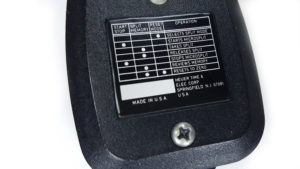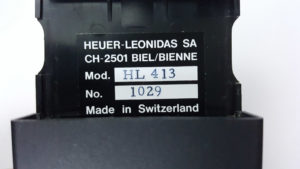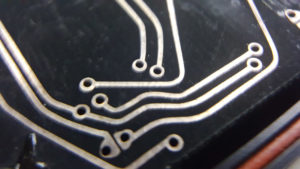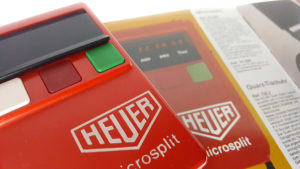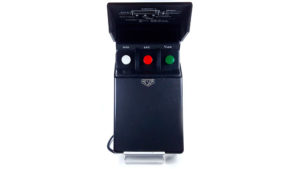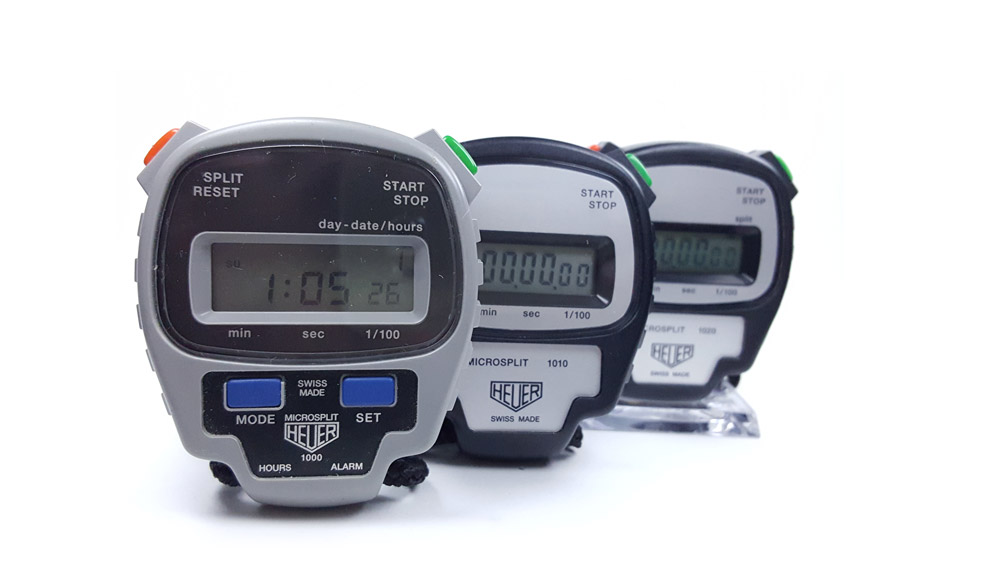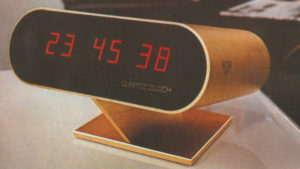Regularity and technic
When running, a mecanical timing device gains or losts more seconds than a quartz electronic one.
Just compare 70’s HEUER mecanical and electronic timers. After one hour working, mecanical model has a 0.5 second to 1.5 second spread error when the electronic one is limited to 0.05 second.
Regularity of a timing system (watch, stopwatch, clock …) depends on the oscillator, an essential part of the movement delivering energy at every time duration. Shorter this interval is, more accurate the movement is.
For a mecanical movement this value generaly varies between 1/4th and 1/10th of second, while it goes down from 1/25000th to 1/32000th for a quartz electronic caliber. Moreother, electronic caliber are free of physical friction, which disturbs regularity.
The oscillator of a mechanical movement is made up of ten or so small parts that block and then periodically let the hands gears turning. For an electronic movement there are several types of oscillator. The most common is the quartz crystal which vibrates when electric goes though. In this document, unless explicitly mentioned, an electronic movement is regulated by a quartz crystal.
From very first forerunners to Jack Heuer
Short historical background of electronic in watchmaking
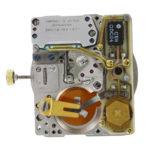
If solid-state electronic components with quartz oscillators massively rise during the 70’s, watchmakers and engineers are already thinking, decades before, to use electricity instead mecanical power to improve time measurement.
The first quartz clock is built and presented in 1927 by the Bell Laboratory. Far more regular than the mecanical models, quartz clock are the new timing references in the world until their replacement by atomic clocks.
However at this period, a such equipment is bigger as a small fridge and can not fit a wristwatch. In the 50’s, few watch compagnies choose to work on no quartz electrical calibers that can be embedded in a watch. Lip and Hamilton developp electrical-mecanical mecanisms while Bulova introduces in 1960 an electronical tuning fork regulated movement.
Finally with developpement of solid-state electronic components and miniaturisation progress, the swiss researchers from the CEH (Centre Electronique Horloger / Electronical Horology Center) and the japanese watchmaker Seiko present the first electronical quartz movements in 1967. It’s a true big step as they are ten times regular than the mecanical ones.
Jack Heuer’s gut feeling
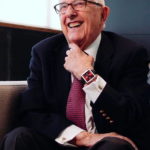
In the 1951, Jack Heuer is 18. He has to choose university studies he wants to follow, after having brightly passed the final high school exam, the Matura. Altought he is still not interested in the familly business, he decides to become an eletrical engineer, thinking this new technologies could one day engined stopwatches ! Pretty good idea.
Worldwild technologies
USA
Discovering Silicon Valley high tech revolution
In 1971 Jack Heuer visits the Silicon Valley (California) new high technologies compagnies, twelve years after having launched the US HEUER subsidiary (1959), and sixteen years after his first trip to the US (1955). He is really impressed and, maybe a little bit upset, by last solid-state developpments made by the local startups.
The visit of one of them, Intel, whith its founder Robert Noyce, gives him an idea of the awesome potential of the new electronic components in watchmaking industry.
From this moment he understands the coming revolution. He decides to anticipate it to make his compagny a leader in digital stopwatches and timing device systems.
Bulding a network of US chips providers
Electronic chips are a central element in HEUER new electronical products. But before manufacturing them “in house”, Jack Heuer builds a network of US compagnies to provide the precious components.
Some of them, like LCD of LED display units, are specially designed for the swiss watchmaker needs. Stopwatches are still mounted in Switzerland but very few models (probalby for US market) are fully made in US.
Switzerland
The HEUER electronic division in Bienne
From the mid 60’s, after HEUER has merged with Leonidas, Jack Heuer is thinking about developping electronic technologies, he foresees they are playing soonly a major role in the watch industry.
In this way, a whole dedicated department, the Electronic division, is established in Bienne. By the time, its activity is growing and, in 1970, few months before Jack Heuer’s trip in Silicon Valley, a big deal is done with the formula one Ferrari team ! The “centigraph“, an advanced 1/1000th of a second timekeeping device is created following itialian sport cars requirements.
HEUER enthusiasts remember Jean Campiche taping on the large centigraph touch, like a pianist. The centigraph is operational for the 1971 formula one. It’s a true success and a great contribution in Ferrari winnings in formula 1.
HEUER and the swiss electronic know-how
Back from US, Jack Heuer wants to use these promising chips for timers. In 1972 the first electronic microsplit stopwatch is released. The pocket size red box features a 1/10th second chips, replaced in 1972 by a 1/100th one.
Sold under the reference HL. 820, it becomes the smaller electronic timer with a such precion. This record is beaten in 1974 by the elegant Richard Sapper designed stopwatches (ref.530, 520).
If HEUER uses US made chips and componenents, the growing know-how of its electronic engineers allows the manufacture to make more complex operations in Switzerland. On the other side as part of electronic devices gets bigger in the sales, HEUER invests in its high tech department. In the second part of the 70’s, the compagny is able to produce their in-house electronic watch modules and designs two digital chronographs (the “Senator Chronoplit” and the “Manhatan Chronostplit”).
HMT (HEUER Microtechnic), a swiss expert in electronic
In 1978, HEUER founds with the german firm Eurosil, the compagny HMT (for HEUER Microtechnic), specialised in Electronic engineering, making so proud Jack Heuer.
Expertise in these high tech field is pretty rare in Europe in the late 70’s and gives to HEUER an advance in manufacturing super accurate devices. New fields of expertise and skills, like directly working on tiny chips, are now handled by HEUER.
Analysing from now, Jack Heuer believing in potential of a such entreprise is unbelievably right. Electronic and chips are absolutely everywhere, and like gaz or oil, they rule the economical world.
Just see how shortage, happened in 2020, impacted industries from game console to car production.
Unfotunatly, because of the economic crisis HEUER has to struggle with, HMT is sold at the end of 1979; less than two year after its creation. HMT still exists today and is an actor in Electronics market.
East Asia
Early 80’s are very hard for swiss horlogery industry. After HMT selling, HEUER electronic devices are manufactured by the subcontrator IDT located in Hong-Kong and which will be Jack Heuer’s employer after he leaves his compagny in 1982.
HEUER, leader in electronic measurement devices
Time keeping
Microsplit range : pocket size electronical stopwatches
HEUER is well known by professionnals and amators throught its microsplit range of electronical pocket size timers, launched in 1972 and produced until approximatively early 2000’s. microsplit odyssey starts in 1972 with the pretty confidential ref. HL 812, a red box case timer with a LED screen, enables to time at 1/10th of second.
It is replaced in 1973 by the HL. 820, displaying timing results at 1/100th of second. It’s a world first one which will be soonly a standart. Next years, technologies improvements are getting faster allowing more features in always smaller devices.
To reduce case size, HEUER hires in 1973, the german designer Richard Sapper who squeezes, in a thin
elegant black box, all electronic componenents to time at 1/100th of second. One of these models, the ref. 520 is exposed at the MOMA museum.
Around 1977/78, Sapper works again with the manufacture to “dress” the new slimest LCD screen devices. These next generations of timers are more legible in the sun and low battery consummer than the former LED screen ones. And for some of them, energy saving is improved by solar cells.
In 1980, Microsplit stopwatches stop being limited to the traditionnal lap and split functions,
available on most of thems since the HL. 820. Large memory of the ref. 250 allows to save time records up to 250 while the ref. 1000 offers day/date display and programmable alarm clock.
Countdown, large screen, multitime unit display timing comes in 1986 trought the successors of the ref. 1000 and its variants, launched just before Jack Heuer’s departure. With a range of laboratory purpose devices, this second release of the 1000 range timers is the last manufactured by HEUER which becomes Tag HEUER. With few other models, 1000 range timers keeps being improved and marketed for quite a long time, making their shape case familliar to collectors. microsplit line ends in around first decade of 2000 with fews devices like the ms 200 before beeing replaced by the pocket pro timers.
Analogic quatrz powered timers
They are exception. The 8 days quartz master time dashboard looks to be the only one referenced in 80’s catalogs.
Advanced time keeping devices
To time sport races (ski, car, horse …) HEUER develops in the 70’s a large set of advanced electronic devices connected to each other.
Basic architecture is built on detector devices like cameras, photocells or depart guns sending impulse signals to a central unit which calculates and saves time records. Already in the late 60’s, the microtimer and BCD timer, cadenced with a tuning fork can measure 1/1000th of second ! From the early 70’s quartz oscillator powers eletronic devices, like the famous centigraph designed for formula one Ferrari team. Linked to keyboards, it can track simultaneously 20 cars and prints results in milliseconds. While other large units like the minitimer HL 107 offer new possibilities, the pocket size microsplit HL 820 and HL 840 can also received external signals and be integrated in complex timing systems.
In the mid 70’s, Jack Heuer with his electronic engineer team, initiates a project, he qualifies himself as a revolution. The ACIT (Automatic Car Identification Timing System) is based on transponders embedded in cars. A computer calculates time results of cars tracked and identified by this wireless system. Firstly discontinued, the ACIT, is finaly completed by Tag HEUER in 1992 and becomes a standart in formula one.
Daily use clocks
The rare beautiful sought after LED desktop clocks ref. 732.2 and 731.1 are produced between 1973 and 1974. Manufacturing prematurely ceases due to the quick obsolence of an electronic component the provider stops making. However they stay in catalogs until the end of the 70’s.
Then to attract a young public, quartz analogic clocks are designed like helmet of famous formula one drivers. Marketed during the 70s’ and 80’s, under HEUER and Tag-HEUER brands, iconic drivers of this time (Jacky Ickx, Niki Lauda, James Hunt, Ayrton Senna, Alain Prost …) have their model.
Chronographs and wristwatches

(credit : utdesign)
In 1975 HEUER presents the “Chronosplit”, the first electronic solid-state chronograph in the world ! It has two screens each controled by a different circuitry but regulated by a unique quartz oscillator. The top LCD display shows hour and date and the bottom LED one is for a split-function stopwatch.
In 1977, with technology improvement, the LED screen is replaced by a second LCD one to preserve battery. The same year, the Manathan GMT chronosplit is introduced, providing in an original case, a classical analogic dial and a LCD screen module, featuring split stopwatch, date and second hour. This kind of chronograph is sometimes named Digiana for “Digital Analogic” offering possibitilty to have two timezones. The last HEUER electronic chronograph big name is the Senator, an another Digiana released in 1979.
Beside these three major models, HEUER (then Tag HEUER) produces in the late 70’s, 80’s and later a great variety of electronic chronographes and watches. Enumarating and describing all, requires an entire chapter, but few things are intersting to highlight. First, the large part of classical wrist watches, unusual for HEUER used to manufacture chronographs. In 1977 the Manathan comes out with a simple three hand version like one of the electronic declinations of the Kentucky chronograph. Then, thin electronic modules fits well with women watches, not adapted to thick mecanical caliber. At last, solid-state circuitry is an opportunity for HEUER to be creative as well as in design as in functionalities.
Electronical measurement diversification
With a such mastery of electronic, HEUER could consider extending its skills in high accuracy measurement beyong timekeeping. That’s why in the second part of the 70’s, the compagny prototypes a puslemeter and a multimeter (an instrument to measure electricity parameters). Maybe too much “avant-gardiste” for this period, these projects encounter technical difficulties. Technologies limitations ot that time block from their finalisation and industrialization. A provider from Silicon Valley can’t supply a component compatible to HEUER expectations for the multimeter, and blood pressor detectors were not enought sensitive to be efficient for a running usage for the puslemeter. Finaly over 40 years laters, health monitoring is a reallity through the Tag HEUER connected.
Conclusion : back to the futur ?!
Mecanical HEUER (and Tag HEUER) timepieces are obviously wordly renowned. From the first Mikrograph timer to the famous caliber 11, the manufacture has worked to divided time unit and accuracy trough its mecanical calibers. And in 2011 Tag HEUER exposed the mikrotimer flying, the fastest mecanical wristwatch chronograph able to time at 1/1000th of second !
However enthusiasts know the essential role of electronic in HEUER history during the second part of the last century, making the compagny a reference in hight-accuracy timekeeping. Under the direction of Jack Heuer, former electrical engineer, devices integrate new revolutionary solid state chipsets from the silicon Valley. Seeing potential of this groundbreaking technologies, Jack Heuer develops a specialized department and founds a chip manufacturing plant (HMT). Unfortuatly his plans are broken by economical crisis. Years afterward, in 2020, electronic componenent becomes a crucial ressource. In the same time, with Frederic Arnault, an engineer is back to the commands of the compagny, working on electronical and hight tech devices like the Tag HEUER connected.
Time to test your knowledge
Check you are ok with HEUER and electronic by passing the test below :
picture credits
– Picture 1 (First quartz swiss caliber) : “Omega Electroquartz date and non date movements rear” by omega-collector under CC BY-SA 4.0.
– Picture 2 : extract from the video TAG Heuer – A Sitdown with Jack Heuer by Jura Watches under cc by 3.0
– Picture 3 : chronosplit caliber by utdesign (ig:@utdesign)
Feel free to share suggestions or improvements for this article using this form.

